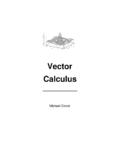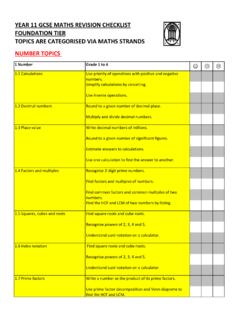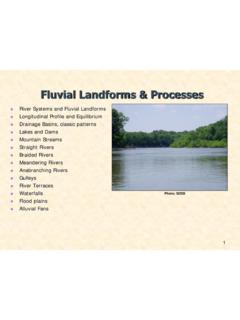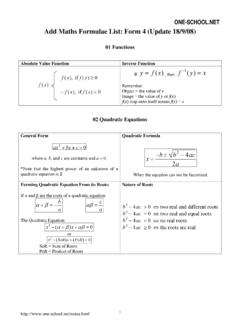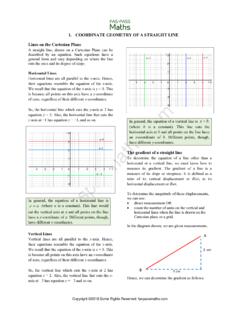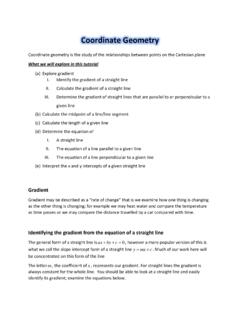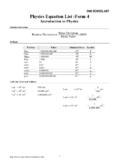Transcription of Vector Calculus
1 1. z 0. -10. -5. -10 0 x -5. 0 5. y 5 10. 10. Vector Calculus Michael Corral Vector Calculus Michael Corral Schoolcraft College About the author: Michael Corral is an Adjunct Faculty member of the Department of Mathematics at Schoolcraft College. He received a in Mathematics from the University of California at Berkeley, and received an in Mathematics and an in Industrial & Operations Engineering from the University of Michigan. This text was typeset in LATEX 2 with the KOMA-Script bundle, using the GNU Emacs text editor on a Fedora Linux system. The graphics were created using MetaPost, PGF, and Gnuplot. Copyright 2008 Michael Corral. Permission is granted to copy, distribute and/or modify this document under the terms of the GNU Free Documentation License, Version or any later version published by the Free Software Foundation; with no Invariant Sections, no Front-Cover Texts, and no Back-Cover Texts. A copy of the license is included in the section entitled GNU Free Documentation License.
2 Preface This book covers Calculus in two and three variables. It is suitable for a one-semester course, normally known as Vector Calculus , Multivariable Calculus , or simply Calculus III . The prerequisites are the standard courses in single-variable Calculus ( Calculus I and II). I have tried to be somewhat rigorous about proving results. But while it is important for students to see full-blown proofs - since that is how mathematics works - too much rigor and emphasis on proofs can impede the flow of learning for the vast majority of the audience at this level. If I were to rate the level of rigor in the book on a scale of 1 to 10, with 1 being completely informal and 10 being completely rigorous, I would rate it as a 5. There are 420 exercises throughout the text, which in my experience are more than enough for a semester course in this subject. There are exercises at the end of each sec- tion, divided into three categories: A, B and C. The A exercises are mostly of a routine computational nature, the B exercises are slightly more involved, and the C exercises usu- ally require some effort or insight to solve.
3 A crude way of describing A, B and C would be Easy , Moderate and Challenging , respectively. However, many of the B exercises are easy and not all the C exercises are difficult. There are a few exercises that require the student to write his or her own computer pro- gram to solve some numerical approximation problems ( the Monte Carlo method for approximating multiple integrals, in Section ). The code samples in the text are in the Java programming language, hopefully with enough comments so that the reader can figure out what is being done even without knowing Java. Those exercises do not mandate the use of Java, so students are free to implement the solutions using the language of their choice. While it would have been simple to use a scripting language like Python, and perhaps even easier with a functional programming language (such as Haskell or Scheme), Java was cho- sen due to its ubiquity, relatively clear syntax, and easy availability for multiple platforms. Answers and hints to most odd-numbered and some even-numbered exercises are pro- vided in Appendix A.
4 Appendix B contains a proof of the right-hand rule for the cross prod- uct, which seems to have virtually disappeared from Calculus texts over the last few decades. Appendix C contains a brief tutorial on Gnuplot for graphing functions of two variables. This book is released under the GNU Free Documentation License (GFDL), which allows others to not only copy and distribute the book but also to modify it. For more details, see the included copy of the GFDL. So that there is no ambiguity on this matter, anyone can make as many copies of this book as desired and distribute it as desired, without needing my permission. The PDF version will always be freely available to the public at no cost (go to ). Feel free to contact me at for iii iv Preface any questions on this or any other matter involving the book ( comments, suggestions, corrections, etc). I welcome your input. Finally, I would like to thank my students in Math 240 for being the guinea pigs for the initial draft of this book, and for finding the numerous errors and typos it contained.
5 January 2008 M ICHAEL C ORRAL. Contents Preface iii 1 Vectors in Euclidean Space 1. Introduction .. 1. Vector Algebra .. 9. Dot Product .. 15. Cross Product .. 20. Lines and Planes .. 31. Surfaces .. 40. Curvilinear Coordinates .. 47. Vector -Valued Functions .. 51. Arc Length .. 59. 2 Functions of Several Variables 65. Functions of Two or Three Variables .. 65. Partial Derivatives .. 71. Tangent Plane to a Surface .. 75. Directional Derivatives and the Gradient .. 78. Maxima and Minima .. 83. Unconstrained Optimization: Numerical Methods .. 89. Constrained Optimization: Lagrange Multipliers .. 96. 3 Multiple Integrals 101. Double Integrals .. 101. Double Integrals Over a General Region .. 105. Triple Integrals .. 110. Numerical Approximation of Multiple Integrals .. 113. Change of Variables in Multiple Integrals .. 117. Application: Center of Mass .. 124. Application: Probability and Expected Value .. 128. 4 line and Surface Integrals 135. line Integrals .. 135. Properties of line Integrals.
6 143. Green's Theorem .. 150. v vi Contents Surface Integrals and the Divergence Theorem .. 156. Stokes' Theorem .. 165. Gradient, Divergence, Curl and Laplacian .. 177. Bibliography 187. Appendix A: Answers and Hints to Selected Exercises 189. Appendix B: Proof of the Right-Hand Rule for the Cross Product 192. Appendix C: 3D Graphing with Gnuplot 196. GNU Free Documentation License 201. History 209. Index 210. 1 Vectors in Euclidean Space Introduction In single-variable Calculus , the functions that one encounters are functions of a variable (usually x or t) that varies over some subset of the real number line (which we denote by R). For such a function, say, y = f (x), the graph of the function f consists of the points (x, y) =. (x, f (x)). These points lie in the Euclidean plane, which, in the Cartesian or rectangular coordinate system, consists of all ordered pairs of real numbers (a, b). We use the word Euclidean to denote a system in which all the usual rules of Euclidean geometry hold.
7 We denote the Euclidean plane by R2 ; the 2 represents the number of dimensions of the plane. The Euclidean plane has two perpendicular coordinate axes: the x-axis and the y-axis. In Vector (or multivariable) Calculus , we will deal with functions of two or three variables (usually x, y or x, y, z, respectively). The graph of a function of two variables, say, z = f (x, y), lies in Euclidean space, which in the Cartesian coordinate system consists of all ordered triples of real numbers (a, b, c). Since Euclidean space is 3-dimensional, we denote it by R3 . The graph of f consists of the points (x, y, z) = (x, y, f (x, y)). The 3-dimensional coordinate system of Euclidean space can be represented on a flat surface, such as this page or a black- board, only by giving the illusion of three dimensions, in the manner shown in Figure Euclidean space has three mutually perpendicular coordinate axes (x, y and z), and three mutually perpendicular coordinate planes: the x y-plane, yz-plane and xz-plane (see Figure ).
8 Z z c P(a, b, c). yz-plane b y xz-plane y 0 0. a x y-plane x x Figure Figure 1. 2 CHAPTER 1. VECTORS IN EUCLIDEAN SPACE. The coordinate system shown in Figure is known as a right-handed coordinate system, because it is possible, using the right hand, to point the index finger in the positive direction of the x-axis, the middle finger in the positive direction of the y-axis, and the thumb in the positive direction of the z-axis, as in Figure z x 0. y Figure Right-handed coordinate system An equivalent way of defining a right-handed system is if you can point your thumb up- wards in the positive z-axis direction while using the remaining four fingers to rotate the x-axis towards the y-axis. Doing the same thing with the left hand is what defines a left- handed coordinate system. Notice that switching the x- and y-axes in a right-handed system results in a left-handed system, and that rotating either type of system does not change its handedness . Throughout the book we will use a right-handed system.
9 For functions of three variables, the graphs exist in 4-dimensional space ( R4 ), which we can not see in our 3-dimensional space, let alone simulate in 2-dimensional space. So we can only think of 4-dimensional space abstractly. For an entertaining discussion of this subject, see the book by A BBOTT .1. So far, we have discussed the position of an object in 2-dimensional or 3-dimensional space. But what about something such as the velocity of the object, or its acceleration? Or the gravitational force acting on the object? These phenomena all seem to involve motion and direction in some way. This is where the idea of a Vector comes in. 1 One thing you will learn is why a 4-dimensional creature would be able to reach inside an egg and remove the yolk without cracking the shell! Introduction 3. You have already dealt with velocity and acceleration in single-variable Calculus . For example, for motion along a straight line , if y = f (t) gives the displacement of an object after time t, then d y/dt = f (t) is the velocity of the object at time t.
10 The derivative f (t) is just a number, which is positive if the object is moving in an agreed-upon positive direction, and negative if it moves in the opposite of that direction. So you can think of that number, which was called the velocity of the object, as having two components: a magnitude, indicated by a nonnegative number, preceded by a direction, indicated by a plus or minus symbol (representing motion in the positive direction or the negative direction, respectively), f (t) = a for some number a 0. Then a is the magnitude of the velocity (normally called the speed of the object), and the represents the direction of the velocity (though the + is usually omitted for the positive direction). For motion along a straight line , in a 1-dimensional space, the velocities are also con- tained in that 1-dimensional space, since they are just numbers. For general motion along a curve in 2- or 3-dimensional space, however, velocity will need to be represented by a multi- dimensional object which should have both a magnitude and a direction.
